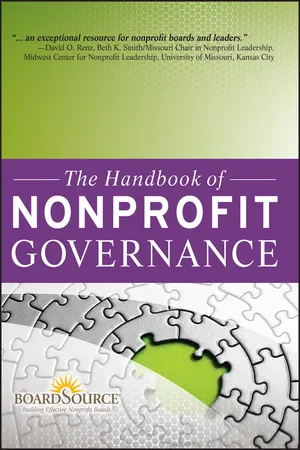
- English
- ePUB (mobile friendly)
- Available on iOS & Android
About this book
THE HANDBOOK OF NONPROFIT GOVERNANCE
From BoardSource comes The Handbook of Nonprofit Governance. This comprehensive resource explores the overarching question of governance within nonprofit organizations and addresses the roles, structures, and practices of an effective nonprofit.
The Handbook of Nonprofit Governance covers the topics that are of most importance to those charged with creating and sustaining effective leadership, including building a board; succession planning; policies; financial oversight; fundraising; planning; strategic planning processes; risk management; and evaluation of the board, CEO, and organization.
Praise for The Handbook of Nonprofit Governance
"This is the first book I've found that covers the topic of governance from A to Z. I know what I'll be assigning the students in my governance class as a textbook next semester!"
—TERRIE TEMKIN, founding principal, CoreStrategies for Nonprofits, Inc.
"BoardSource has prepared an exceptional resource for nonprofit boards and leaders. This comprehensive volume offers timely and relevant information about board work and governance, including practical tools and resources that will be valuable to all types of nonprofits."
—DAVID O. RENZ, chair, department of public affairs; Beth K. Smith/Missouri Chair in Nonprofit Leadership; and director, Midwest Center for Nonprofit Leadership; University of Missouri, Kansas City
"If you are involved in nonprofit organizations, and if you ever have doubts about how they are best run, this is the book for you-and BoardSource is the place to turn."
—FISHER HOWE, consultant, Lavender/Howe & Associates, and author, The Nonprofit Leadership Team
BoardSource (formerly the National Center for Nonprofit Boards) is the premier resource for practical information, tools and best practices, training, and leadership development for board members of nonprofit organizations worldwide.
Frequently asked questions
- Essential is ideal for learners and professionals who enjoy exploring a wide range of subjects. Access the Essential Library with 800,000+ trusted titles and best-sellers across business, personal growth, and the humanities. Includes unlimited reading time and Standard Read Aloud voice.
- Complete: Perfect for advanced learners and researchers needing full, unrestricted access. Unlock 1.4M+ books across hundreds of subjects, including academic and specialized titles. The Complete Plan also includes advanced features like Premium Read Aloud and Research Assistant.
Please note we cannot support devices running on iOS 13 and Android 7 or earlier. Learn more about using the app.
Information
PART ONE
GOVERNANCE PRINCIPLES, ROLES, AND STRUCTURE
CHAPTER ONE
IN THE SPIRIT OF SERVICE: INTRODUCTION TO THE NONPROFIT WORLD
The only ones among you who will be really happy are those who will have sought and found how to serve.
- Public-sector organizations exist to serve the public good. They are part of governmental structures and are financed largely by tax revenues.
- Private-sector organizations exist to produce a profit for their owners. To do so they must meet the needs of a constituency who will pay for their goods or services.
- Nonprofit-sector organizations exist to serve a social purpose, a constituency, or a cause. To do so successfully, they must earn or raise sufficient funds to cover expenses and safeguard the organization’s future. They are not prohibited from creating excess revenue over expenses, but such surplus must be used to support the organization’s mission, not to be distributed as private gain. In nonprofit organizations there are no individual owners who can claim organizational assets for their own benefit.
An Overview of the Nonprofit Sector
Public Charities
- Relief of the poor, distressed, or underprivileged
- Advancement of religion
- Advancement of education and science
- Creation or maintenance of public buildings or monuments
- Lessening of the burden of government
- Elimination of prejudice and discrimination
- Defense of human and civil rights
- Combating of community deterioration and juvenile delinquency
Foundations
- Private foundations usually have a single source of funding (an individual, a family, or a business), and use income from investments to make grants to charitable nonprofit organizations. The Ford Foundation, the Carnegie Corporation of New York, and the W. K. Kellogg Foundation are well-known examples. Corporate foundations are private foundations that receive funding from—and make grants on behalf of—a corporation. The MetLife Foundation and the American Express Foundation are examples. Many corporations have in-house corporate giving programs instead of or in addition to corporate foundations.
- Operating foundations are “hybrid” foundations that use the bulk of their resources to carry out their own charitable programs, while also making grants to other charities. The Carnegie Endowment for International Peace and the J. Paul Getty Trust are examples of operating foundations.
- Community foundations pool the resources of many donors and focus their grantmaking on a particular city or region. The Cleveland Foundation and the New York Community Trust are examples of community foundations. The IRS classifies community foundations as publicly supported charities, not private foundations. These groups are not subject to excise taxes or distribution requirements like private foundations, and donations made to them by individuals are tax deductible.
Social Welfare Organizations
Table of contents
- Cover
- Table of Contents
- Essential Texts for Nonprofit and Public Leadership and Management
- Title
- Copyright
- Have You Used These BoardSource Resources?
- Acknowledgements
- Introduction
- PART ONE: GOVERNANCE PRINCIPLES, ROLES, AND STRUCTURE
- PART TWO: GOVERNANCE PRACTICES
- APPENDIX: SAMPLE POLICIES FOR NONPROFIT BOARDS
- GLOSSARY
- RESOURCES
- INDEX
- End User License Agreement